Publication
Article
Pharmacy Practice in Focus: Health Systems
COPD: Improving Disease Management
Author(s):
Effective management of COPD can improve quality of life for patients and help reduce rehospitalizations.
Effective management of COPD can improve quality of life for patients and help reduce rehospitalizations.
Background and Impact
Chronic obstructive pulmonary disease (COPD) is a chronic condition characterized by persistent airflow obstruction that is usually progressive and associated with an enhanced inflammatory response in the airways and lung tissue as a result of exposure to noxious particles or gases.1 Following decades of inattention to COPD management improvement, it is now the third leading cause of death in the United States with 134,676 deaths in 2010.2 There is renewed interest in COPD management opportunities, and recently updated international guidelines provide recommendations regarding best practices.3
An estimated 12.7 million US adults (18 years and older) were diagnosed with COPD in 2011.4 However, nearly 24 million US adults have evidence of impaired lung function, indicating that COPD is underdiagnosed,5 and an estimated 15 million adults (6.3% of US adults) have been told by a health care provider that they have COPD.6
COPD affects more women than men, and its prevalence in women has risen steadily over several decades as smoking rates among women have increased. Women were more likely to report COPD than men (6.7% compared with 5.2%).6
Death rates for COPD declined among US men over the decade between 1999 and 2010, with rates of 57.0 and 47.6 per 100,000, respectively; however, there was no significant change among death rates in women over the same period (35.3 and 36.4 per 100,000, respectively).7 In 2010, more than 70,000 women died compared with more than 64,000 men.2
In addition to the significant morbidity and mortality from COPD, there is a substantial cost of care. In 2009, the economic impact of COPD was estimated at $49.9 billion in the United States, including $29.5 billion in direct medical costs, $12.4 billion due to mortality, and $8 billion due to morbidity, including lost productivity.8
Etiology
Smoking is the primary risk factor for COPD. Approximately 20% of smokers develop COPD, although they are at risk for developing other smoking related diseases, as well, and nearly 80% of COPD deaths are caused by smoking.4 Female smokers are nearly 13 times as likely to die from COPD as women who have never smoked, while male smokers are nearly 12 times as likely to die from COPD as men who have never smoked.9 Other environmental pollutants and exposures also contribute to COPD risk. Successful smoking cessation can slow the progression of COPD and improve survival.
Role of Exacerbations of COPD
Patients with COPD often have other comorbidities that complicate management and contribute to overall disease severity.1 In recent years, the role of exacerbations in COPD has been an area of great interest, including strategies to prevent and minimize the risk of exacerbations. COPD exacerbations are associated with disease progression and an increased risk of death. The goals of COPD management are directed toward reducing symptoms and preventing complications (Table 1).
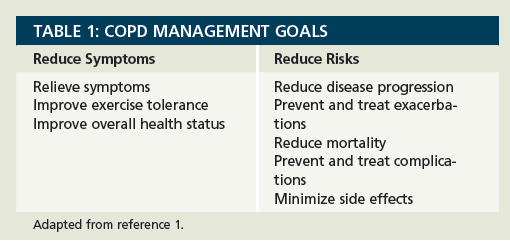
In addition to improving overall outcomes in patients with COPD, minimizing the risk and occurrence of exacerbations is important for economic reasons, as well. The payment model for medical care is evolving to focus on quality of care and is referred to as value-based purchasing.10 Hospitals and health systems are compensated based on several metrics that reflect the quality of care and are rewarded for care that emphasizes value and improved patient outcomes. There are even penalties for readmissions related to specific diseases. Recently, the Centers for Medicare & Medicaid Services implemented a penalty for readmission of a patient hospitalized for a COPD exacerbation within 30 days of discharge. In response to this, and in the interest of improving care of patients, health systems have implemented programs to improve transitions of care between the inpatient and ambulatory care settings.
COPD Management
There are numerous opportunities for pharmacists to contribute to improved outcomes for patients with COPD and to reduce the risk for exacerbations. They include education, counseling, provision of medical supplies, and medication reconciliation. Evidence-based guidelines are available for the management of COPD, and pharmacists can collaborate with other clinicians to optimize medication use.1 Attention can also be directed toward smoking cessation, if needed, and the provision of influenza and pneumococcal vaccines.
The focus of COPD management should be placed on achieving the goals for optimal outcomes, including reducing exacerbation risks. Pharmacotherapy recommendations are based on a rating of COPD severity, which considers lung function, symptom severity, and exacerbation history and risk (see Figure).1 COPD was historically categorized based on lung function as measured by spirometry alone; however, in recent years, symptoms and exacerbation risk in severity have been taken into consideration. Clinicians use multiple assessments to determine COPD severity (see Tables 2 and 3, and Online Table 411).
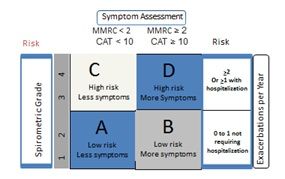
CAT = COPD Assessment Test score; MMRC = Modified Medical Research Council score.
Adapted from reference 1.
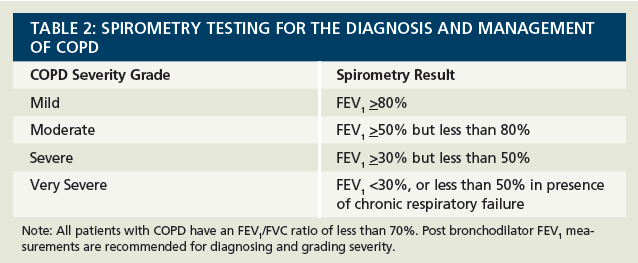
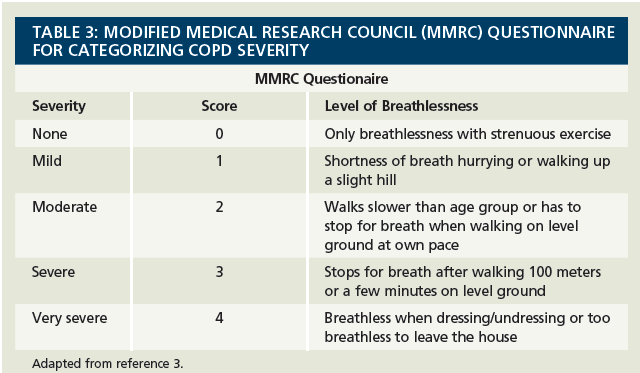
Table 4: Chronic Obstructive Pulmonary Disease (COPD) Assessment Test
Patient is asked to rank the impact of their COPD on each of the following from 0 to 5a
0 = least severe impact, 5 = most severe impact
- Cough
- Phlegm (mucus)
- Chest tightness
- Breathless walking up a hill or 1 flight of stairs
- Activity limitations
- Confidence to leave home
- Sleep
- Energy
aTotal score ranges from 0 to 40
Adapted from reference 11.
Focus on Pharmacotherapy
There are various classes of medication used in the treatment of COPD (see Online Table 5), with specific therapies recommended based on a patient’s classification after symptom assessment (Online Table 6). Currently, there is no pharmacotherapy option that has been proven to impact the natural course of COPD. Therapies are effective at relieving symptoms, and many chronic therapies also reduce exacerbation risks.
Table 5: Pharmacotherapy Options for COPD
- Beta2-agonists Short-acting beta2-agonists Long-acting beta2-agonists
- Anticholinergics Short-acting anticholinergics Long-acting anticholinergics
- Combination short-acting beta2-agonists + anticholinergics in one inhaler
- Combination long-acting beta2-agonists + anticholinergics in one inhaler
- Methylxanthines
- Inhaled corticosteroids
- Combination long-acting beta2-agonists +corticosteroids in one inhaler
- Phosphodiesterase-4 inhibitors
- Systemic corticosteroids
Adapted from reference 3.
Table 6: Recommended Chronic Obstructive Pulmonary Disease Therapies Based on Patient Group
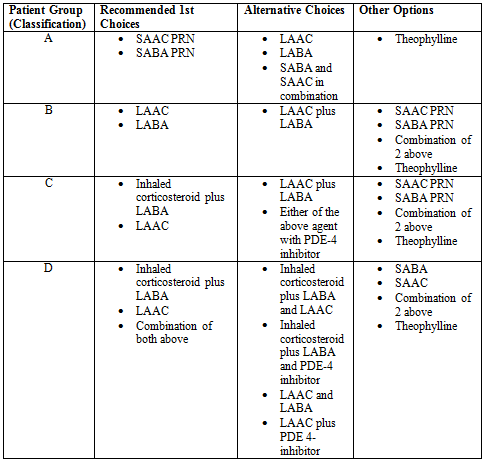
LAAC = long-acting anticholinergic; LABA = long-acting B2-agonist; PDE-4 = phosphodiesterase-4; PRN = as needed; SAAC = short-acting anticholinergic; SABA = short-acting beta2-agonist.
Adapted from reference 3.
For patients with mild symptoms that occur intermittently, a short-acting bronchodilator (eg, albuterol or ipratropium) is appropriate alone or in combination. Once the patient endorses symptoms that occur more frequently, or chronically, long-acting bronchodilators are more convenient and more effective. Between beta agonists and anticholinergics (antimuscarinics), there is no consistent evidence that either is the superior therapy, so both are viable treatment options. While inhaled long-acting bronchodilators are generally considered safe, some patients may experience minor side effects, and one observational study concluded that the use of either class increases the risk of hospitalization from COPD.12 Both long-acting beta agonists and anticholinergics were associated with this risk, and there was no difference in risk between the classes. This finding requires further assessment because the progression of COPD itself also increases the risk for COPD exacerbations.
Other therapies, including phosphodiesterase (PDE)-4 inhibitors and inhaled corticosteroids, are indicated for patients with more severe COPD. The primary advantage of either class is reduced exacerbation risk. Inhaled corticosteroids do increase the risk of respiratory tract infections in patients with COPD.13
The traditional approach to using medications for COPD has been to add new therapies sequentially; stopping or switching medications has not been commonly employed. Recently, researchers have explored the possibility of stepping down therapy in patients who are well controlled.14 The possibility of discontinuing inhaled corticosteroids in COPD patients who are well controlled is one suggestion. This strategy is supported by the introduction of new treatment combination products to the US market, including products that contain 2 long-acting bronchodilators. The guidelines for COPD management do support the use of 2 long-acting bronchodilators in the absence of an inhaled corticosteroid, but this has not been commonly employed. With new combination products, this treatment option may be attractive. A variety of new drugs for the treatment of COPD have been introduced to the US market over the last few years (Online Table 7).
Table 7: New Drugs for Treatment of Chronic Obstructive Pulmonary Disease
- Aclidinium bromide (Tudorza Pressair) Long-acting anticholinergic twice daily
- Albuterol and ipratropium (Combivent) Respimat delivery device four times daily
- Fluticasone and Vilanterol (Breo Ellipta) ICS and LABA
- Indacaterol maleate (Arcapta Neohaler) LABA once daily
- Olodaterol (Striverdi Respimat) LABA once daily
- Roflumilast (Daliresp) PDE-4 inhibitor (oral) once daily
- Tiotropium Bromide (Spiriva Respimat) LAMA once daily
- Vilanterol and Umeclidinium (Anoro Ellipta) LABA and LAMA
- Tiotropium and Olodaterol (Pending) LAMA and LABA
ICS = inhaled corticosteroid; LAAC = long-acting anticholinergic; LABA = long-acting beta2-adrenergic antagonist; LAMA = long-acting muscarinic antagonist; PDE = phosphodiesterase.
The benefit of long-acting bronchodilators (both beta agonists and anticholinergics), inhaled corticosteroids, and PDE-4 inhibitors is their ability to reduce exacerbation frequency. Each class of medications alone has been shown to reduce exacerbation frequency about 20% to 25%. The benefit from combinations of these agents is less clear in terms of a further reduction in exacerbation risk.
Conclusions
The quality of COPD management is a crucial focus for our health care system. There are numerous opportunities for pharmacists to positively impact COPD management and to work with patients to improve outcomes. Education about the disease and its management are essential. Pharmacists can collaborate with other health care providers to ensure that pharmacotherapy is appropriate. Similarly, pharmacists should advise patients to avoid exposures that cause COPD and contribute to disease progression, including tobacco. Pharmacists can recommend and provide necessary vaccines and suggest treatment modalities (eg, supplemental oxygen, nebulizers). Based on the role of inhaled medications in COPD management, pharmacists should monitor patients’ adherence and ability to use inhalation devices. Pharmacists should take a leadership role in the management of transitions of care and in collaborating with other clinicians, including pharmacists in other practice settings, to improve the quality of care for COPD patients.
Dennis Williams, PharmD, BCPS, AE-C, is associate professor and vice-chair for professional education and practice in the division of pharmacotherapy and experimental therapeutics at UNC Eshelman School of Pharmacy in Chapel Hill, North Carolina.
References
- Pocket guide to COPD diagnosis, management, and prevention: a guide for health care professionals (revised 2011). The Global Initiative for Chronic Obstructive Lung Disease website. www.goldcopd.org/uploads/users/files/GOLD_Pocket_May2512.pdf. Accessed February 2015.
- Murphy S, Xu J, Kochanek K. National Vital Statistics Reports. Deaths: Final Data for 2010. Hyattsville, MD: Centers for Disease Control and Prevention. www.cdc.gov/nchs/data/nvsr/nvsr61/nvsr61_04.pdf. Published May 8, 2013.
- Global strategy for the diagnosis, management, and prevention of chronic obstructive pulmonary disease (updated 2015). The Global Initiative for Chronic Obstructive Lung Disease website. www.goldcopd.org/uploads/users/files/GOLD_Report_2015.pdf.
- Chronic obstructive pulmonary disease fact sheet. American Lung Association website. www.lung.org/lung-disease/copd/resources/facts-figures/COPD-Fact-Sheet.html. Accessed February 2015.
- Chronic obstructive pulmonary disease fact sheet. National Institutes of Health website. http://report.nih.gov/nihfactsheets/Pdfs/ChronicObstructivePulmonaryDisease%28NHLBI%29.pdf. Accessed March 2015.
- Chronic obstructive pulmonary disease among adults — United States, 2011. MMWR Morb Mortal Wkly Rep. 2012;61(46):938-943.
- COPD death rates in the United States. Centers for Disease Control and Prevention website. www.cdc.gov/copd/data.htm. Accessed February 2015.
- Mapel DW, Roberts MH. New clinical insights into chronic obstructive pulmonary disease and their implications for pharmacoeconomic analyses. Pharmacoeconomics. 2012;30(10):869-885.
- Office of the Surgeon General. The Health Consequences of Smoking: 50 Years of Progress: A Report of the Surgeon General. Atlanta, GA: US Department of Health and Human Services; 2014. www.surgeongeneral.gov/library/reports/50-years-of-progress/full-report.pdf. Updated January 2014. also from fact sheet, ref 3
- Hospital value-based purchasing. Centers for Medicare & Medicaid Services website. http://cms.gov/Medicare/Quality-Initiatives-Patient-Assessment-Instruments/hospital-value-based-purchasing/index.html?redirect=/Hospital-Value-Based-Purchasing. Accessed February 2015.
- Jones PW, Harding G, Berry P, Wiklund I, Chen WH, Kline Leidy N. Development and first validation of the COPD Assessment Test. Eur Respir J. 2009;34(3):648—654.
- Gershon A, Croxford R, Calzavara A, et al. Cardiovascular safety of inhaled long-acting bronchodilators in individuals with chronic obstructive pulmonary disease. JAMA Intern Med. 2013;173(13):1175-1185. doi:10.1001/jamainternmed.2013.1016.
- Calverley PM, Anderson JA, Celli B, et al. Salmeterol and fluticasone propionate and survival in chronic obstructive pulmonary disease. N Engl J Med. 2007;356(8):775-789. Doi: 10.1056/NEJMoa060070.
- Magnussen H, Disse B, Rodriguez-Roisin R, et al. Withdrawal of inhaled glucocorticoids and exacerbations of COPD. N Engl J Med. 2014;371(14):1285-1294. doi: 10.1056/NEJMoa1407154.







